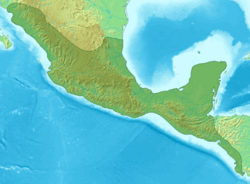Malinalco (archeological site) facts for kids
| Location | Malinalco, Mexico, |
|---|---|
| Region | Mexico State |
| Coordinates | 18°56′50.96″N 99°29′26.89″W / 18.9474889°N 99.4908028°W |
| History | |
| Periods | Late Preclassic to Late Classic |
The Cuauhtinchan Archeological Zone, also known as the Malinalco Archeological Zone, is an amazing ancient site. It sits on a hill called Cerro de los Idolos (Hill of the Idols). This hill rises 215 meters above the town of Malinalco in Mexico.
Many old buildings were built on terraces carved into the side of the hill. The most important structures are right at the top. This site is one of the most significant Aztec places. It was found in 1933 and explored by José García Payón in 1935.
The buildings you see today are from the Aztec Empire period. However, people used this spot as a special ceremonial center much earlier. The main sanctuary complex was built between the mid-1400s and early 1500s. To reach the Cerro de los Idolos, you have to climb 426 stairs, which go up 125 meters! Along the way, signs tell the area's history in Spanish, English, and Nahuatl.
The site has six buildings. The most important one is the Cuauhcalli or House of the Eagles, built around 1501. What makes it special is that it was carved right out of the hill itself. The building looks like a pyramid with its top cut off. This shape was chosen because there wasn't much flat space on the hill.
The Cuauhcalli is a unique building carved from a single piece of rock. It has been compared to famous ancient sites like the Ellora Caves in India, Petra near the Dead Sea, and Abu Simbel in Egypt. This was a sacred place for the Eagle Warriors. They performed important ceremonies here, like initiation rites.
A thirteen-step staircase leads into this temple. On each side of the stairs are two sculptures of big cats facing the plaza. The Cuauhcalli has two rooms: one is rectangular, and the other is circular. There's an opening in the wall connecting them. After being carved, the walls and ceiling were covered in stucco and painted with murals. Most of these paintings are now almost gone.
The entrance to the upper part of the temple looks like the open jaws of a serpent. It even has fangs, eyes, and a forked tongue painted red. A thatched roof, made from the grass the area is named after, covers this upper section.
Exploring the Cuauhcalli
Just inside the entrance, on the east side, you'll see a sculpture of a serpent's head. On top of it are the remains of a statue of an Eagle Warrior. On the west side, there's another large sculpture. It looks like a big pedestal and represents a tlapanhuéhuetl, which was a war drum. Above this drum sculpture is a cipactli. This is a mythical creature, sometimes called an "earth monster." The cipactli is holding up a person, but only their sandals are left. People believe these two statues were like flags or standards.
Further inside the temple, there's a bench that curves around a space. This horseshoe-shaped bench has four sculptures. The most impressive one is an eagle facing the entrance. Two other sculptures are also eagles, while the fourth is a jaguar. The jaguar statue looks like its skin is spread out, as if it were a hunting trophy.
Behind the eagle sculptures, there is a cuauhxicalli. This was a special sacred bowl used to hold the hearts of people offered in sacrifice. The Aztecs believed these individuals would then become messengers to the sun. The way the building is lined up matches the movement of the stars. Before a thatched roof was added to protect it, openings in the walls would create amazing light effects at certain times, like during the summer solstice.
Important Discoveries
A large wooden huéhuetl, a ceremonial war drum, was found here. It is now displayed at the Museum of Anthropology and History in the Mexiquense Cultural Center in Toluca.
During the spring and fall equinoxes, many people visit the site. About 5,000 to 7,000 visitors come to see this ancient place. The cone-shaped thatched roof that covers the main building is a copy of what the original roof probably looked like. However, the shed-like porch at the front is not as close to the original design. Even though there has been some damage over time, the inside of this building is still in good condition.
Cuauhtinchan Images
See also
 In Spanish: Zona arqueológica de Malinalco para niños
In Spanish: Zona arqueológica de Malinalco para niños
- Teotenango
- Xochicalco








